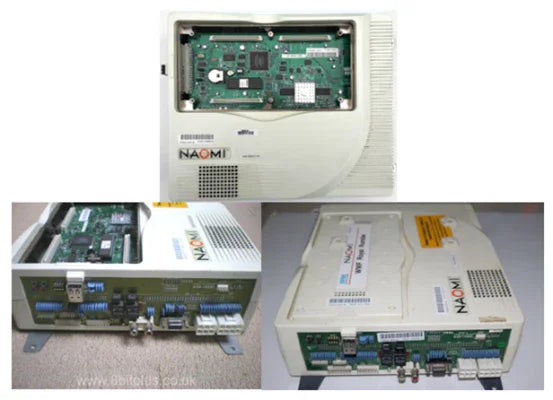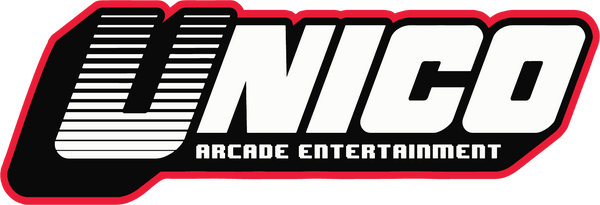
Welcome Unico Nova Blast Candy Cab Fans!
Welcome Unico Nova Blast Candy Cab fans join us today on another journey to history making arcade moments today we will be looking at history making hardware of known as the Sega NAOMI.
This is one of our most beloved arcade hardware created and what it brought to the gaming scene like the DreamCast, Atomiswave, and numerous Sega gaming titles and partnerships.
The Sega NAOMI is one of the most influential arcade systems in video game history. Here's a detailed history and overview:
🕹️ Sega NAOMI: History & Impact
📅 Launched: 1998 (Japan), 1999 (Worldwide)
🎮 Overview:
The Sega NAOMI is an arcade system board developed by Sega AM2 and manufactured by Sega. It was the direct successor to the Sega Model 3 and a pivotal part of Sega's move into the Dreamcast era, sharing much of the Dreamcast’s hardware architecture.
🔧 Technical Specs
- CPU: Hitachi SH-4 200 MHz (same as Dreamcast)
- GPU: PowerVR2 CLX2
- RAM: 32 MB main + 16 MB graphic + 8 MB sound
- Media: ROM cartridges, GD-ROM (via NAOMI GD-ROM extension)
- Multiboard Linking: Could link multiple boards for multiplayer (e.g., up to 4 for Daytona USA 2)
💡 Key Innovations
- Dreamcast Compatibility: Essentially an arcade version of the Dreamcast, making ports between the two platforms much easier and cost-effective.
- Modular Design: Support for cartridge and GD-ROM media meant easy updates and long-term use.
- Multiplayer Capability: NAOMI allowed linking up to 16 cabinets in some configurations.
- Extended Lifespan: Its modular, scalable design kept it relevant for over a decade.
🎮 Core Highlights of the SEGA NAOMI Platform
The NAOMI ("New Arcade Operation Machine Idea") launched in 1998, featuring Dreamcast-equivalent architecture but with more memory and improved performance, and supported both ROM and GD-ROM formats.
🔥 Notable Games on NAOMI
Here's a broad overview featuring fan favorites, spanning genres from racing to fighting:
Racing / Driving
- Crazy Taxi (1999): Groundbreaking open-world driving with fast-paced thrills
- F355 Challenge (1999): Realistic racing simulation on dedicated NAOMI hardware
- The House of the Dead 2 (1998): One of NAOMI’s launch titles; decisive in light-gun arcade style
- The Typing of the Dead (1999): Unique keyboard shooter variant, ported later to Dreamcast Fighting & Beat‑'em‑Up
- Power Stone (1999) & Power Stone 2 (2000): Fast-paced 3D arena fighters supported by Capcom .
- Capcom vs. SNK 2 (2001): Epic crossover brawls enabled by NAOMI–Dreamcast synergy
- Dead or Alive 2 (1999): Tecmo’s visually rich 3D fighter ported from NAOMI
- Cannon Spike (2000): Arcade-only Capcom shooter/beater mixing action heroes
- SpikeOut (1998): Toshihiro Nagoshi’s 3D beat-’em-up, originally on Model 3 but later on NAOMI Samba de Amigo (in 2000): Maraca-based rhythm gameplay by Sonic Team, a standout experience Other Gems
- Virtua Tennis and Virtua Striker 2: NAOMI-powered sports titles with arcade-level polish
- Jambo! Safari: Light-hearted driving with charming wildlife themes
- Under Defeat: Renowned shoot-’em-up praised in retro circles
🕹️ Notable Games
Some of the most iconic arcade titles in the late '90s and early 2000s ran on NAOMI:
|
Title |
Developer |
Year |
|
Marvel vs. Capcom 2 |
Capcom |
2000 |
|
Guilty Gear X |
Arc System Works |
2000 |
|
18 Wheeler: American Pro Trucker |
Sega |
2000 |
|
Zombie Revenge |
Sega |
1999 |
🏭 Adoption by Other Companies
While developed by Sega, the NAOMI was licensed to other major publishers, most notably:
- Capcom – Developed many fighting games using the NAOMI hardware.
- Namco, Sammy, Tecmo, and SNK also produced NAOMI-based games.
Capcom even developed a proprietary version: NAOMI GD-ROM + Capcom I/O converter to make it compatible with standard JAMMA cabinets.
These features are what makes this arcade board a must purchase or the duo they did with Sammy to make the Atomiswave which lead to more titles being released.
🔄 Successors
- NAOMI 2 (2000) – Enhanced version with more RAM and dual PowerVR graphics chips for better 3D performance.
- Sega Chihiro – Based on original Xbox hardware.
- Sega Lindbergh – Later-generation platform used through the mid-2000s.
🏁 Legacy
- Widely Emulated: Today, NAOMI is emulated on PC through emulators like Demul and Flycast.
- Dreamcast Ports: Its compatibility meant many NAOMI arcade games got nearly 1:1 ports to the Sega Dreamcast.
- Long Lifecycle: Used in arcades well into the late 2000s, especially in Asia and Europe.
🧠 Fun Facts
- Marvel vs. Capcom 2 was one of the most played NAOMI-based fighters ever.
- Some NAOMI cabinets had interchangeable headers for easy game swapping.
- Because of Dreamcast's early discontinuation, NAOMI kept many of its titles alive in arcades.
Here’s a pictorial journey through the Sega NAOMI’s history — an arcade powerhouse with a legacy and rich history we at Unico cannot but admire and enjoy gaming till our hearts content on.

🎮 ________________________________________
1️⃣ Origins & Launch
- Debut: First unveiled at JAMMA in late 1998, NAOMI (New Arcade Operation Machine Idea) succeeded the Model 3 arcade hardware and shared its core architecture with the Sega Dreamcast.
- Global rollout: Released in Japan in Nov 1998, followed almost immediately worldwide
2️⃣ Architecture & Tech Specs
- CPU & GPU: Powered by a 200 MHz Hitachi SH‑4 CPU and PowerVR 2 graphics. Compared to Dreamcast, NAOMI offered double the system/graphics memory and quadruple the sound RAM
- Memory layout: 32 MB main RAM, 16 MB video RAM, 8 MB audio RAM. Media formats included ROM cartridges (up to ~168 MB) or GD‑ROM via a DIMM board for disk loading
3️⃣ Hardware Variants
- First Edition: Early aluminum-cased boards used in titles like The House of the Dead 2
- Multiboard: Combined up to 16 units for complex visuals or multi-screen setups; used in titles like F355 Challenge
- NAOMI 2 (2000): Enhanced version with dual PowerVR CLX2 GPUs, doubled RAM, improved geometry. Backward compatible with NAOMI titles
- Hikaru & System SP: Specialized models—Hikaru focused on advanced shading (Phong, particle effects); System SP was a cost-reduced variant (like “Aurora”) using flash cards
- Atomiswave: Sammy’s arcade platform built on NAOMI architecture
4️⃣ Game Library & Lifecycle
- Major hits: Crazy Taxi, Marvel vs. Capcom 2, Virtua Tennis, Dead or Alive 2, Power Stone, House of the Dead 2, Monkey Ball
- Arcade mainstay: Supported by Sega and third-party publishers (Capcom, Taito, SNK) from 1998 to around 2009 — a lifespan rivaling Neo‑Geo .
5️⃣ Legacy & Influence
- Dreamcast synergy: Hardware commonality facilitated seamless arcade-to-home ports — DAT used in Dreamcast and venues
- End of proprietary era: NAOMI marked Sega’s last in-house arcade architecture before shifting to PC-based systems (Chihiro, Triforce)
- Collector's gem: Remains a popular platform for collectors and restorers, often featured in "universal" NAOMI cabinets .
- Emulation & homebrew: Emulated via platforms like Demul and Flycast; still supported with new GD-ROM and ROM releases well into the 2000
🧠 Snapshot Table
|
Variant |
Launch Year |
Key Upgrades |
|
NAOMI |
1998 |
Base board: 200 MHz SH‑4, 32/16/8 MB RAM, ROM/GD built |
|
NAOMI Multiboard |
~1999 |
Multiple boards in parallel for advanced visuals |
|
NAOMI 2 |
2000 |
Dual GPUs, more RAM, improved resolution & power |
|
Hikaru |
~1999–2001 |
Phong shading, network-capable, niche use |
|
System SP |
Mid‑2000s |
Flash storage variant, budget titles |
|
Atomiswave |
2004 |
Sammy’s console based on NAOMI hardware |
🎯 Summary:
Sega NAOMI revolutionized arcade economics and gameplay by repurposing console architecture and offering modular upgrades. Its enduring success, expansive game catalog, and robust design cement its legacy as one of the most iconic arcade platforms of all time.
Thanks for taking the time to take a stroll with us into some of the defining moments in arcade history with the Sega NAOMI along with what Sega with partnerships created. Be on the outlook for our next post talking about arcade history.
